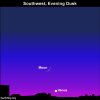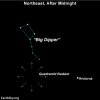There’s a lot to see and think about on the night of January 2, 2014! First, as darkness falls, look for the young moon and planet Venus low in the twilight. You’ll need an unobstructed view in the direction of sunset, and you’ll need to look very shortly after the sun goes down, when the sky is still bright with twilight. Then grab a nap and plan to watch in the wee hours on January 3 for a possible show of Quadrantid meteors. This meteor shower will peak sometime during the hours between midnight and dawn for North America on January 3. If you’re in Asia watch during those same hours January 4. Elsewhere in the world, try either date, or both!


This meteor shower favors the Northern Hemisphere. That’s because its radiant point – the point in the sky from which the meteors appear to radiate – is far to the north on the sky’s dome.
Plus the Quadrantid meteor shower is capable of matching the meteor rates of the better known August Perseid and December Geminid showers. It has been known to produce up to 50-100 or more meteors per hour in a dark sky.
So why isn’t the Quadrantid shower as celebrated as the Perseid and Geminid showers? It’s because the Quadrantid shower has a narrow peak that lasts for only a few hours. If you miss the peak – which is easy to do – you won’t see many meteors.
If you’re thinking of watching the Quadrantids, do it. Meteor shower peaks are rarely certain, and sometimes a gamble on a shower will reward you with a good show. Just be aware you might not see a whole lot of meteors! No matter where you are in the Northern Hemisphere, the best time to watch is between midnight and dawn, local time. Fortunately, yesterday’s new moon guarantees moon-free nights for watching the January 2014 Quadrantid meteor shower!
The Quadrantid shower is named after the defunct 19th century constellation Quadrans Muralis. If you trace the paths of the Quandrantids backward, they appear to radiate from a point where this constellation once reigned in the sky. If you wish, you can locate the Quadrantid radiant in reference to the Big Dipper and the bright star Arcturus. Use the chart at the top of this post.
But you don’t need to find the radiant to enjoy the Quadrantids. You need a dark, open sky, and you need to look in a general north-northeast direction for an hour or so before dawn. That’s the Quadrantid meteor shower – before dawn January 3 and 4, 2014 – for the world’s northerly latitudes. If you’re in Asia, you might try between midnight and dawn on January 5 as well. Who knows? This shower can produce up to 50 or more meteors per hour, but its peak is rather short and sweet. But it’s worth a try in 2014, since we’re guaranteed of moon-free skies skies for the 2014 Quadrantid meteor shower.
Bottom line: Say goodbye to the dazzling planet Venus in the evening sky on Thursday, January 2, when it appears near the young moon. Venus will soon disappear in our sky. It’ll pass more or less between us and the sun on January 11, then enter the morning sky. On the morning of January 3 (or January 4 for Asia), stay up late, or get up early, and watch for meteors in the annual Quadrantid shower!


This meteor shower favors the Northern Hemisphere. That’s because its radiant point – the point in the sky from which the meteors appear to radiate – is far to the north on the sky’s dome.
Plus the Quadrantid meteor shower is capable of matching the meteor rates of the better known August Perseid and December Geminid showers. It has been known to produce up to 50-100 or more meteors per hour in a dark sky.
So why isn’t the Quadrantid shower as celebrated as the Perseid and Geminid showers? It’s because the Quadrantid shower has a narrow peak that lasts for only a few hours. If you miss the peak – which is easy to do – you won’t see many meteors.
If you’re thinking of watching the Quadrantids, do it. Meteor shower peaks are rarely certain, and sometimes a gamble on a shower will reward you with a good show. Just be aware you might not see a whole lot of meteors! No matter where you are in the Northern Hemisphere, the best time to watch is between midnight and dawn, local time. Fortunately, yesterday’s new moon guarantees moon-free nights for watching the January 2014 Quadrantid meteor shower!
The Quadrantid shower is named after the defunct 19th century constellation Quadrans Muralis. If you trace the paths of the Quandrantids backward, they appear to radiate from a point where this constellation once reigned in the sky. If you wish, you can locate the Quadrantid radiant in reference to the Big Dipper and the bright star Arcturus. Use the chart at the top of this post.
But you don’t need to find the radiant to enjoy the Quadrantids. You need a dark, open sky, and you need to look in a general north-northeast direction for an hour or so before dawn. That’s the Quadrantid meteor shower – before dawn January 3 and 4, 2014 – for the world’s northerly latitudes. If you’re in Asia, you might try between midnight and dawn on January 5 as well. Who knows? This shower can produce up to 50 or more meteors per hour, but its peak is rather short and sweet. But it’s worth a try in 2014, since we’re guaranteed of moon-free skies skies for the 2014 Quadrantid meteor shower.
Bottom line: Say goodbye to the dazzling planet Venus in the evening sky on Thursday, January 2, when it appears near the young moon. Venus will soon disappear in our sky. It’ll pass more or less between us and the sun on January 11, then enter the morning sky. On the morning of January 3 (or January 4 for Asia), stay up late, or get up early, and watch for meteors in the annual Quadrantid shower!
